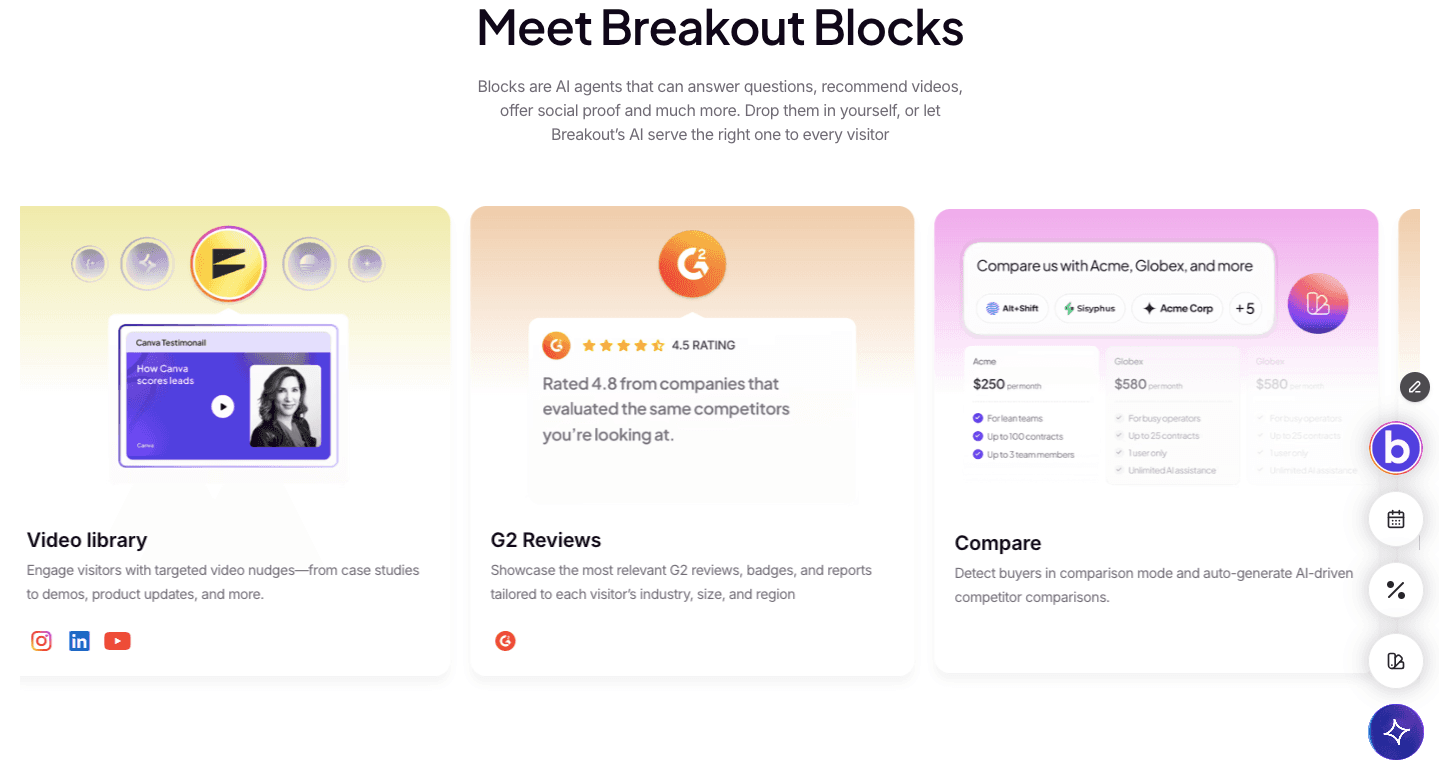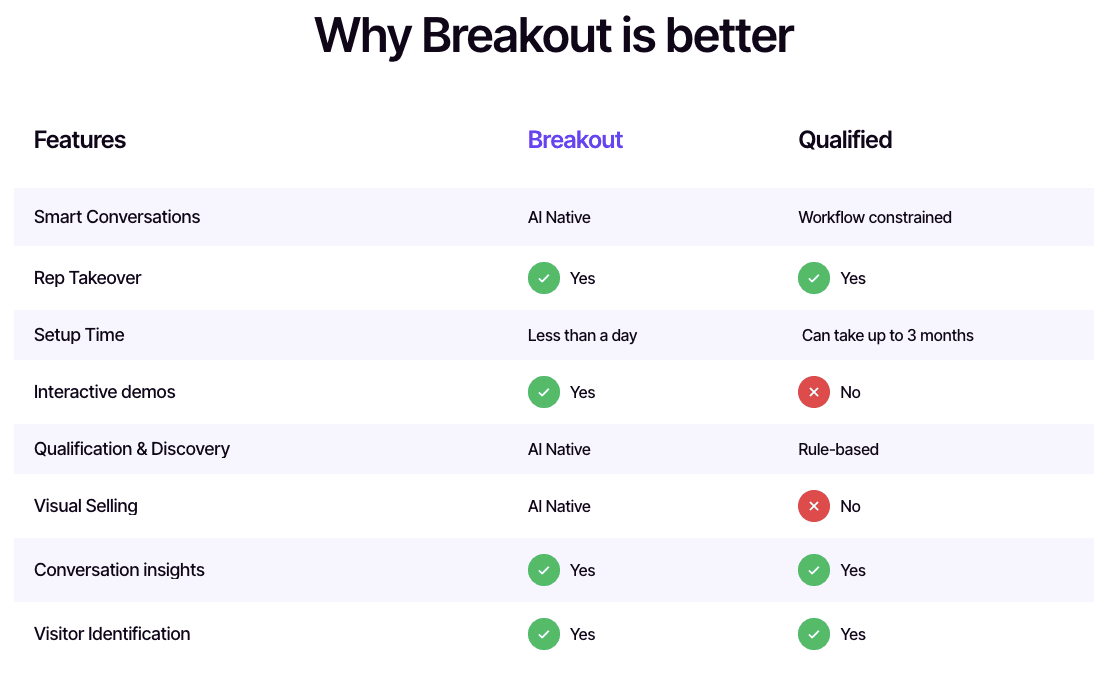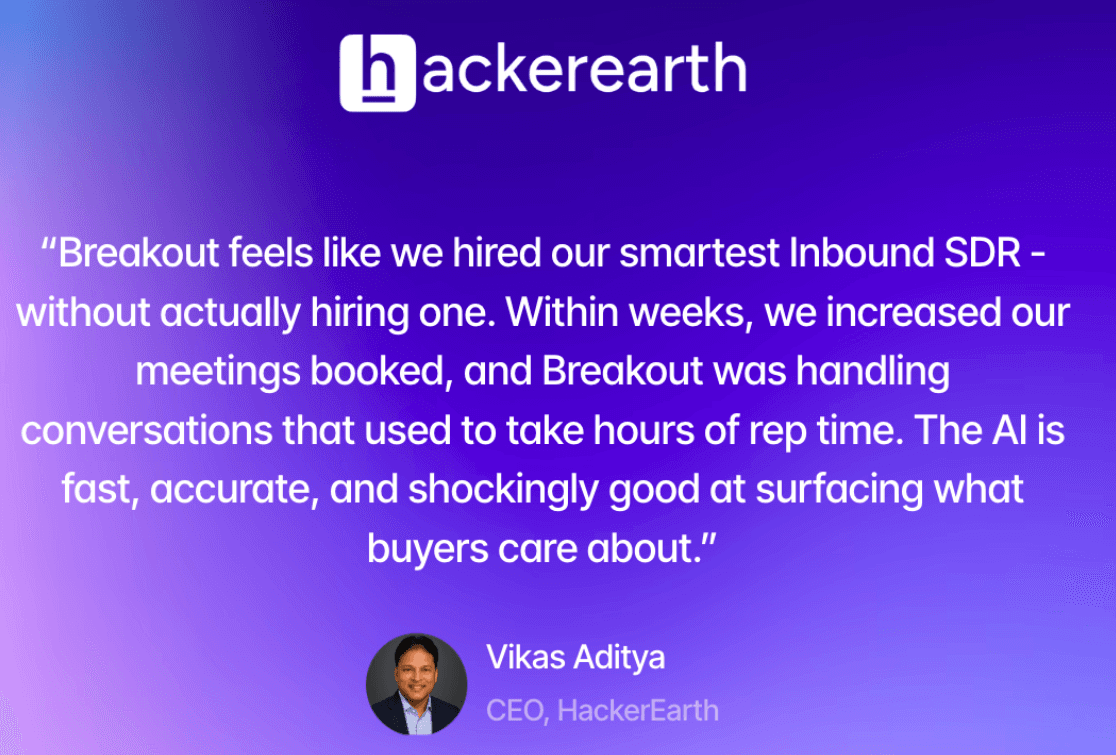Businesses today want a website to feel like a 1:1 sales call.
The classic human-centric approach is being replaced by AI-led systems that work around the clock, customizing and timing interactions like a pro.
Add to that, Deloitte estimates that by 2027, over 50% of enterprises will use AI agents.
Teams that adopt AI-led prospecting have already reported over 40% conversion gains. This is the result of continuous, tailored engagement, not limited by time zones or SDR shifts.
AI SDRs today answer questions, recommend videos, and even pull up interactive demos to engage every website visitor in real time.
Still, all that capability comes with a big question: what’s the real cost?
Qualified has built its name around real-time conversations and precision routing. Yet, it’s one of the priciest tools in this category.
Its pricing places it firmly in enterprise territory. You’re looking at around $42k–$72k per year, before you factor in setup, integrations with Salesforce or 6sense, and the SDR headcount needed to run it all.
Add the complexity of enterprise workflows, and implementation often takes months. For smaller teams, that’s a serious commitment (both financially and operationally).
In this guide, we unpack Qualified pricing for you:
What you’ll really pay
Where costs add up
And the best AI-first Qualified alternatives that suit SMB budgets
We’ve even done the math so you can see pricing and ROI side by side.
If your goal is to cut customer acquisition costs by 40–60% and see 5x more qualified leads in your first 30 days, read on.
TL;DR: Qualified pricing & who should (not) buy
Qualified isn’t for everyone.
It’s powerful, yes, but only when your sales setup matches its design. The platform starts around $42k per year, with staffing and integration costs pushing it higher.
It works best when you have a big SDR team, structured Salesforce data, and patient timelines.
Between setup fees, licenses, and people costs, your true Qualified pricing can cross $100k before results show.
Who should not buy Qualified
Skip it if your CRM isn’t Salesforce or if your SDR coverage is limited.
Its human-heavy model assumes your team can cover inbound leads 24/7, and the admin load adds up fast. For SMBs focused on speed and coverage, the cost-to-impact ratio just doesn’t work.
Verdict by company size, CRM, and SDR coverage
Company Type | Works Well For | Doesn’t Work Well For |
Large enterprise (500+ staff) | Salesforce-first organizations with full-time sales development teams, stacked ABM tools, and drawn-out sales processes | Teams needing faster GTM testing or who can’t justify multi-quarter setup cycles |
Mid-Market (100–500 employees) | Teams combining Salesforce, Marketo, and intent tools like 6sense or Demandbase | Firms running lean RevOps setups or without 24/7 SDR coverage |
SMB (<100 employees) | Not a fit | All SMBs who need fast deployment, minimal maintenance, or flexible cross-CRM workflows |
CRM Fit | Salesforce-native environments with API depth and multi-object sync | SMBs on any other CRM, such as HubSpot, Zoho, or Pipedrive, that lack native parity |
SDR Coverage | Full in-house or outsourced SDR teams supporting live routing | Async or minimal SDR coverage, where automation handles qualification |
Qualified pricing 2025: The real cost behind the list price
We’re now going to look at what you’ll pay for Qualified: what the published tiers cost, how scaling your usage and features adds up, and the time dollar cost of getting it up and running.
Base platform range (~ $42 k–$72 k+ / year)
Pricing for Qualified spans Premier, Enterprise, and Ultimate plans. Prices are usually negotiated directly with the Qualified sales team.
Public estimates show entry-level pricing near $42,000 per year, with advanced tiers going beyond $72,000 yearly.
All plans normally include core capabilities like:
AI SDR Agent Studio behavior for conversation routing
Built-in account segmentation and visitor enrichment
Integration with Salesforce
Full reporting and analytics dashboards
Automated workflows, meeting routing, and email outreach
Add-ons, seats, and more
The base fee only covers standard seats and core use cases. Once you require a high messaging volume, multiple agent profiles, or coverage across multiple brands, costs start to increase.
Add-on modules like enterprise reporting API, research intent signal integrations, or data retention policies tend to hit budgets quickly, especially for high-traffic sites.
Seats for agents or users and CRM licenses add another layer of cost.
Implementation and onboarding (fees + time)
Qualified needs time to deliver value. Real users note that to fully configure dashboards, enable routing rules, train teams, and integrate with CRM takes about 2 to 3 months at a minimum.
If your team lacks a dedicated setup owner or has limited RevOps or sales operations bandwidth, that timeline may stretch, inflating your costs visibly.

Evaluating Qualified's TCO: Platform + people + process
The real expenses of adopting Qualified aren’t limited to subscription fees, extra modules, or onboarding costs.
Breaking costs down by technology, team members, and operational routines gives a more realistic estimate of ongoing effort.
Before we do the math, industry reports state that the average hourly compensation for key roles is as shown below:
SDRs: $26.45 per hour
RevOps: $52.88 per hour
With these rates as a baseline, let's estimate the expenses of managing a system such as Qualified.
The cost of 24/7 coverage
Round-the-clock coverage demands more than careful planning.
We ran the numbers for you.
To ensure 24/7 coverage, your team will need to put in three shifts a day. In a week, that’s 21 shifts.
Let’s say you have one SDR for each shift; you need 3 SDRs to cover the 21 shifts a week.
The annual costs for this will be:
Per SDR: At $26.45 per hour for a 40-hour workweek, each SDR costs roughly $55,016 annually.
For 3 SDRs: Total annual staffing costs reach about $165,048.
The $165,048 figure is without factoring in additional costs like benefits, overtime pay, or training programs.
The admin/ops overhead
After setup, the platform demands continuous operational attention. This includes tasks like updating bot responses, adjusting routing rules, and tracking system performance.
RevOps costs: If a RevOps manager works roughly 5 hours per week on these tasks at $52.88/hour, the weekly cost is $264.40, which totals $13,748 annually.
While not huge, these ongoing efforts contribute to the overall operational expense.
The ROI and break-even points
Calculating how long it takes to recover your investment requires looking at total costs versus the projected returns.
Imagine annual platform, staffing, and operational costs reach $230,000.
With anticipated benefits of $275,000 per year, your break-even timeline is:
$230,000 ÷ $275,000 = 0.8 years, which is 9.6 months (~ 10 months).
Comparing Qualified with AI-first alternatives
While SMB teams often struggle to justify the high cost of legacy platforms like Qualified. Mid-market teams need tools that reduce operational burden while maintaining results.
This is where AI-first alternatives like Breakout come in. Breakout meets SMB needs with lightweight, self-learning automation that works across CRMs and marketing assets. Along with Breakout, we have reviewed more SMB-fit tools ideal for teams seeking lower-cost, high-value alternatives.
Breakout
Most businesses find the combination of Qualified pricing, SDR staffing, and configuration time hard to justify. Breakout offers a different approach.
With AI-led automation, Breakout handles visitor qualification, scoring, and meeting bookings. Teams gain faster outcomes and lower total expenses. It works across Salesforce, HubSpot, and other CRM systems, providing easy deployment and ongoing self-learning.
Breakout Blocks enable SMBs to deliver instant, AI-driven answers to every visitor query.
The conversational AI adjusts to each visitor’s context, capturing BANT information and supporting chat, voice, and interactive product demos. Teams gain deeper insights into visitor intent and account activity without manual intervention.

The platform turns inbound traffic into hand-raisers automatically, covering off-hours and extending coverage at a fraction of the cost of traditional SDR-heavy models. This makes it a strong Qualified alternative for teams seeking enterprise results without enterprise overhead.

Let’s talk pricing
Flexible plans for early-stage companies
Consumption-based tiers for higher usage
Total cost around ¼ of Qualified + SDR staffing
What Breakout does well
Qualify and convert visitors even when reps are away
Self-learns from GTM content and CRM data
AI-driven, tailored visitor journeys
24/7 voice engagement with instant feedback
Interactive demos embedded in live conversations
Deep GTM intelligence from de-anonymized data and persona insights
Seamless integration with multiple CRMs
Limitations to consider
Advanced analytics capabilities are still in development.
Breakout helped HackerEarth achieve a 21% pipeline increase
By deploying Breakout, HackerEarth turned passive website traffic into qualified leads. The AI agent answers queries, guides visitors through interactive experiences, and schedules meetings around the clock.

Results
10–22% conversation-to-lead conversion, handled fully by AI with minimal human intervention
11.4% of new leads came directly from Breakout, with another 9.3% influenced indirectly
2.5% increase in site engagement, showing more visitors actively interacted with product information
Instant insight into visitor intent, including pricing questions and feature interest
Contextual product demos embedded in conversations improved clarity and reduced friction
Budget tools and their trade-offs
Budget alternatives are practical for SMBs and mid-market teams. They cut license costs and reduce dependency on dedicated SDR shifts.
We are listing below two more low-cost options worth considering. And we’re laying out the trade-offs for you to make an informed decision.
Tidio
Tidio merges chat, support, and automation into one system. Its drag-and-drop interface makes bot setup instant. The Lyro AI assistant handles repetitive questions, scores leads, and routes chats to human reps when needed.
The tool is built for e-commerce but is flexible enough for SaaS teams needing conversational automation on a budget.

Features to watch
Visual bot builder for quick setup
Lyro AI for automated replies
Pre-built ecommerce templates
Pricing
Free
Starter: $24.17/month
Growth: $49.17/month
Plus: $749/month
Premium: $2,999/month
Limitations
Not built for complex, role-based conversations
Lacks advanced lead scoring for longer B2B cycles
Scaling to enterprise reporting may require workarounds
HubSpot Chat
HubSpot Chat ties inbound chats directly into your CRM and simplifies handoffs for marketing-led teams.
The tool automates lead capture and meeting scheduling from live chat interactions.

Features to watch
Integrated CRM chat with shared inbox
Drag-and-drop bot builder
Instant meeting scheduling
Mobile access via Slack or the HubSpot app
Pricing
Free basic plan
Paid tiers for automation and routing
Limitations
Limited personalization versus modern LLM agents
Not optimized for ABM or multi-touch demo flows
Lead routing and scoring are basic without upgrades
Qualified pricing 2025: Does the math still add up?
By 2025, Qualified pricing sits at a level that demands proof of return. Mid-market SaaS leaders we spoke with cite annual costs exceeding $100K–$130K once all licenses, ops hours, and routing updates are included.
In contrast, teams adopting AI-led tools like Breakout report faster time-to-value, richer visitor engagement, and cost savings of 40–60%.
Qualified pricing verdict: Reliable, yes. Scalable for SMBs, less so.
Rethink your inbound math. Get AI-native orchestration that pays back in months, not years. Schedule a demo with Breakout.
FAQs
How much does Qualified cost in 2025?
While Qualified doesn’t list public pricing, industry estimates suggest annual contracts between $42K and $72K, depending on features, user count, and CRM integrations. Enterprise contracts can go higher based on support and routing complexity.
What hidden costs should I expect beyond the license?
Beyond the base license, expect added expenses for staffing, bot setup, training, and analytics. Many teams also spend on CRM connectors, routing updates, and dedicated operations time.
Does Qualified have usage-based or seat-based pricing?
Qualified pricing combines seat-based and feature-based billing. You pay per user license, with costs scaling by features, routing logic, and connected systems.
How long does Qualified take to implement?
Expect a setup period of 30 to 60 days. Smaller deployments move faster, while enterprise teams with layered workflows take longer due to data mapping.
What’s the best cheaper alternative to Qualified for SMB/mid-market?
For small and mid-market SaaS teams, Breakout delivers faster time-to-value and a lower total spend. Its AI SDRs automate qualification, scheduling, and follow-up.























